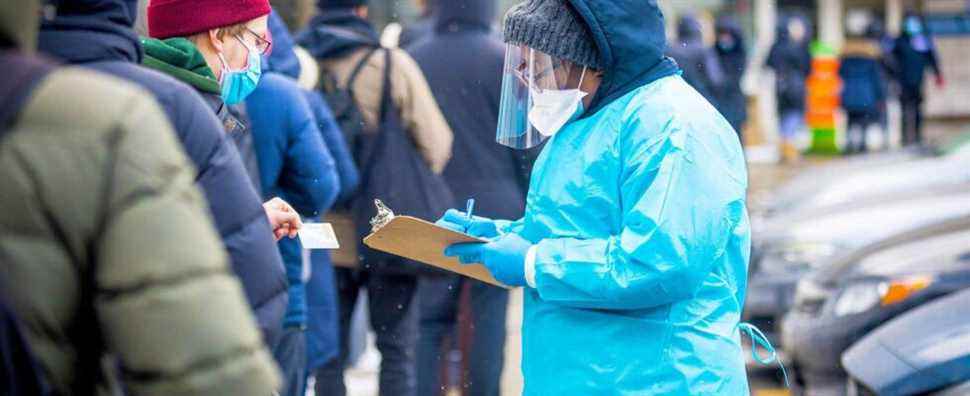The Quebec government on Wednesday clarified the conditions that would allow essential workers with COVID-19 to return to work. This would happen “as a last resort”, and other steps would have to be taken before it got there, including reducing the period of isolation and obtaining negative tests. However, there are many modalities that could cause headaches for employers, who will be responsible for applying them.
Media representatives attended an information session bringing together representatives from the Ministry of Health and Social Services (MSSS) and the Institut national de santé publique du Québec (INSPQ). More details were given on the essential workers who will be affected, in addition to those in the health sector. There is no list, but the changes mainly concern firefighters, police officers, snow removal employees as well as those in the electricity, water and food sectors.
The conditions will not apply to school staff and daycare workers, said the strategic medical adviser of the General Directorate of Public Health of the MSSS, Dr.r Richard Massé. “We are talking about extraordinary measures to preserve services that have a direct impact on health or safety,” he stressed.
At the first stage, in the event that there is no break in service, but an employer wants to avoid it, a firefighter who has been in contact with a positive person, but who is asymptomatic could return to work. after five days of isolation rather than ten. This, on condition of having obtained a negative result in a rapid test on the sixth day. The return of those who received three doses of vaccine will be done first, followed by the return of those who received two doses, and so on. The employee must also be isolated from his colleagues during breaks and meals.
If services are too disrupted and citizens’ safety is at stake, the isolation period could be reduced by three days. A negative rapid test should be obtained on days 4, 5 and 6. If the number of employees is still not sufficient, a positive and asymptomatic worker could return after five days of isolation, without testing, an “almost final step. “. And, if that is still not sufficient, as a last resort, a symptomatic positive worker could return to work after approval by the General Directorate of Public Health, “on a case-by-case basis”.
Contacted by The duty, Alain Lamarre, professor and researcher specializing in immunology and virology at the National Institute for Scientific Research (INRS), is reassured by the methods and finds that they are “well thought out”. However, they could be complicated to apply for some employers. “I would set up a telephone support line where people could explain the process to employers, because it’s a bit technical and it might be a bit complicated for employers who are not used to wade through it, ”suggests the expert.
Different rules in health
The rules will be different for health workers as they work with vulnerable people.
A nurse who has received at least two doses of the vaccine and has been around a positive person in the community or at work would no longer be sent home. However, she should undergo regular screening tests.
If someone she lives with is positive, such as her child, the nurse should instead stay home for seven days. In the event that there is a risk of a break in service and the employee is asymptomatic, this period may be shortened.
If symptoms appear, the person should go home, and a negative test may allow a faster return to work. Eventually, if a person tests positive, the ten-day isolation period could be reduced to seven days for asymptomatic people. “The idea is to bring in people who are less likely to be contagious,” says the medical director of public health protection at the MSSS, Dr Yves Jalbert.
What if a healthcare worker didn’t want to come back to work anyway so as not to risk infecting someone? Richard Massé mentions that the collective agreements will be respected, and appeals to the moral sense of the employees. “If there is a breakdown in service, there is a moral contract, unless there is an impediment that can be discussed, that the service be offered,” he said. There can be a stake in life and death. “
According to Roxane Borgès Da Silva, professor at the School of Public Health of the University of Montreal, it will be necessary to be very careful with the exposure of the workers. “We must ensure that they are all very well protected and that they have access to N95 masks,” she told the Duty.
Positive cases among firefighters
For the moment, the situation is not problematic on the side of several fire departments in the province, says the president of the Union of firefighters and firefighters of Quebec, Daniel Pépin, who represents 2,800 of these professionals. “With the staff they have, that’s enough, and they can provide service to the population. “
The number of positive firefighters is still increasing. The president has carried out checks for Sherbrooke, Trois-Rivières, Lévis and Saguenay, and he estimates that between 8 and 10 firefighters per service are currently infected with COVID-19. “A place like Sherbrooke, 7 out of 180, there is no problem. But other services are smaller, ”he explains.
Firefighters from nearby small municipalities can help each other with problems, he says. Daniel Pépin calls for a 24-hour schedule rather than 12 hours, which would limit contacts by creating more stable “bubbles”.
In Montreal, where there are 2,400 firefighters, about thirty a day are declared positive, while others are returning to work, according to a spokesperson for the Association des pompiers de Montréal. The situation is not problematic for the moment, we are assured.
